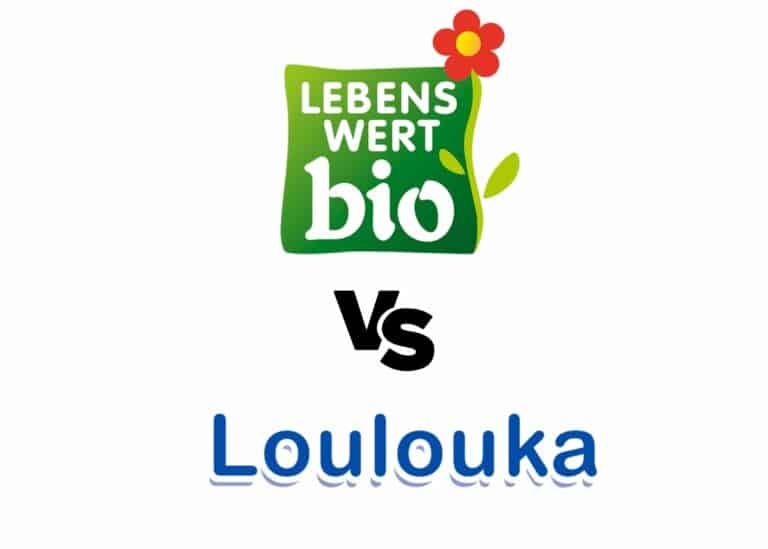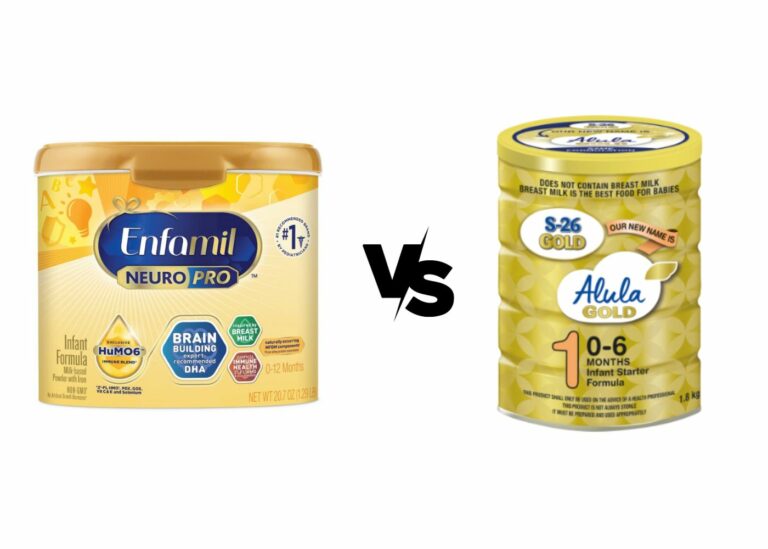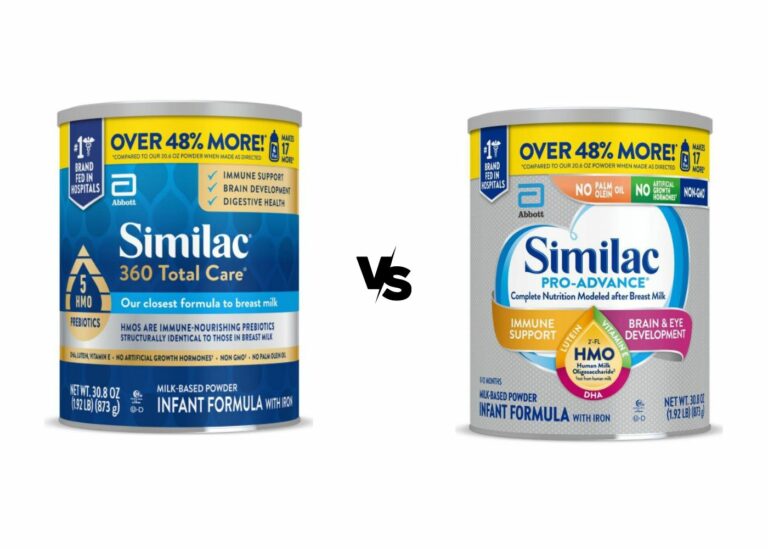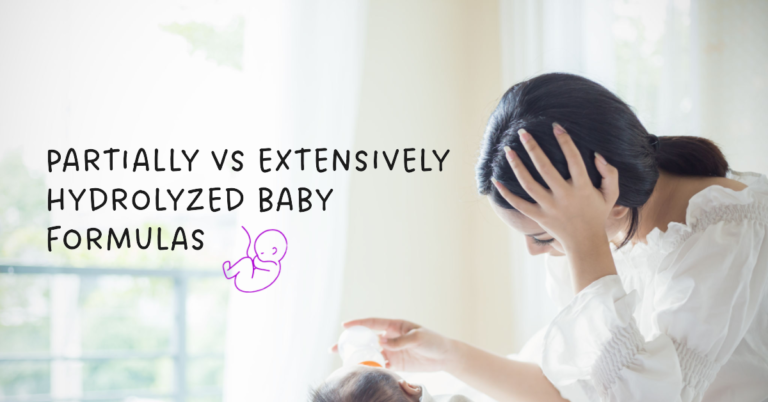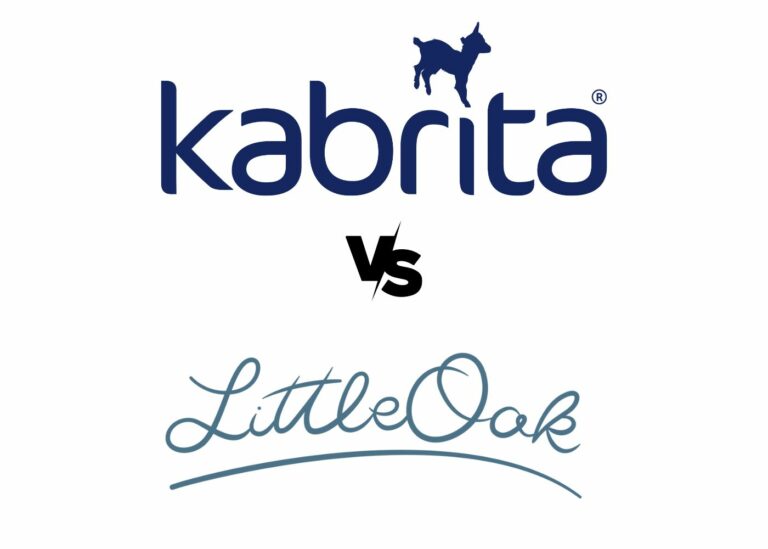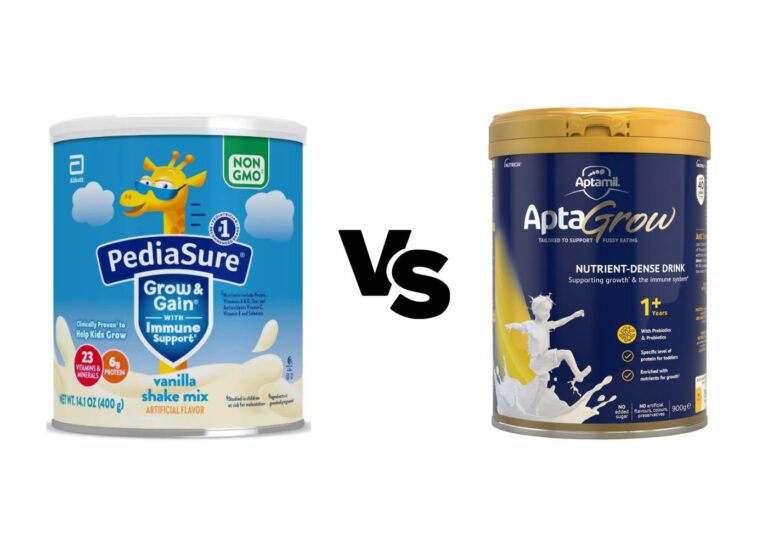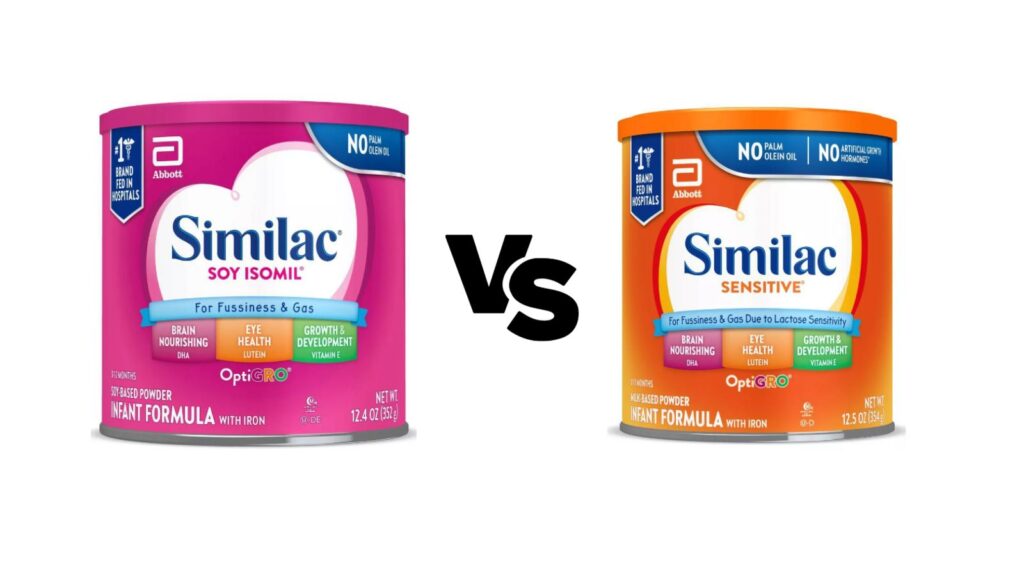
Key Differences Table Between Similac Soy and Sensitive
| Features/Aspect | Similac Soy (Isomil) | Similac Sensitive |
|---|---|---|
| Ideal For | Babies with lactose intolerance or galactosemia | Babies with lactose sensitivity |
| Type | Soy-based formula | Milk-based formula with reduced lactose |
| Primary Protein Source | Soy protein isolate | Milk protein isolate |
| Carbohydrate Source | Corn syrup solids and sugar | Corn syrup solids and sugar |
| Fats and Oils | Soy oil, coconut oil, high oleic sunflower oil | High oleic safflower oil, soy oil, coconut oil |
| Nutritional Support | Fortified with DHA, ARA, vitamins, minerals | Fortified with DHA, ARA, vitamins, minerals |
| Ease of Digestion | Designed for babies with lactose intolerance | Formulated to reduce gas and discomfort related to lactose sensitivity |
| Prebiotics | Short-Chain Fructooligosaccharides (scFOS) | Short-Chain Fructooligosaccharides (scFOS) |
| Specific Benefits | Lactose-free, suitable for vegetarian diet | Reduced lactose, designed to alleviate fussiness and gas |
This article will compare two Similac formulas designed for sensitive babies: Similac Soy vs Similac Sensitive.
We will analyze their nutritional composition and ingredients to help you make the best decision for your baby.
Let’s get after it!
***Important: Soy formulas are not recommended for infants younger than six months of age due to estrogen content and should not be used to treat CMPA until a pediatrician gives the okay.
Related read: Similac Soy vs Total Comfort
Our Short Answer
The choice between Similac Isomil and Sensitive will depend on your baby’s needs, although we anticipate that there are better alternatives of both formulas.
Choose Similac Soy if your baby:
– Is lactose intolerant
– Is 6 months or older
– Is diagnosed with CMPA or galactosemia (and your pediatrician has given you the OK to use soy formulas)Choose Similac Sensitive if your baby:
– Is lactose sensitive
– Does not have a cow’s protein allergyThat said, there are much better alternatives to Isomil and Sensitive (below in the article).
Overview of the Two Formulas
Similac Soy Isomil is a lactose-free and soy-based formula, is ideal for babies with lactose intolerance or galactosemia, offering complete nutrition with DHA/ARA.
Similac Sensitive, designed for lactose sensitivity, contains reduced lactose and milk proteins, aiding in fussiness and gas relief, and is enriched with essential nutrients.
Similac Soy
Similac Soy, also known as Similac Soy Isomil, is formulated for infants who have difficulties digesting lactose, which is the sugar found in milk. This formula is based on soy protein isolate and is lactose-free, making it a suitable alternative for babies with lactose intolerance or galactosemia. However, it’s essential to differentiate between lactose intolerance and milk protein allergies, as they require different types of formula.
Here are some key attributes of Similac Soy:
- Lactose-Free: Best for babies who can’t process lactose effectively.
- Soy-Based: A good option for families seeking a vegetarian protein source or who wish to avoid animal-derived ingredients.
- Complete Nutrition: It contains a blend of vitamins, minerals, and nutrients necessary for your baby’s growth and development.
- DHA/ARA: These are omega-3 and omega-6 fatty acids that support eye and brain development.
Similac Sensitive
Similac Sensitive is designed for fussy and gassy babies who may experience mild discomfort due to lactose sensitivity. Unlike the Soy Isomil, Similac Sensitive still contains milk proteins but has reduced lactose content to ease digestion for those with lactose sensitivity—not to be confused with lactose intolerance.
Consider the following points about Similac Sensitive:
- Reduced Lactose: Suitable for infants with lactose sensitivity.
- Milk-Based: Contains milk protein, not recommended for babies with milk protein allergies.
- Fussiness and Gas Relief: Formulated to reduce gas and discomfort related to lactose sensitivity.
- Nutrient‐Rich: Includes essential vitamins and minerals supporting overall infant health and development.
- DHA/ARA: Featured to support critical brain and eye development.
Nutritional Composition
Similac Soy uses soy protein isolate, suitable for lactose intolerance or vegetarian diets, while Similac Sensitive contains milk protein isolate for lactose sensitivity, not suitable for milk protein allergies.
Both have corn syrup solids and added sugars as carbohydrates, providing necessary energy but not the best choice due to high sugar content.
Both formulas have the same exact blend: soy oil, coconut oil, and high oleic sunflower oil with DHA and ARA.
Protein Content
Proteins are the building blocks of growth and are absolutely vital in the early stages of life. When it comes to baby formulas, protein content and sources can vary to suit different needs.
Similac Soy:
- Source: The key protein source in Similac Soy is soy protein isolate. It’s a complete protein, meaning it contains all the essential amino acids needed for growth.
- Why It Matters: For babies who cannot tolerate cow’s milk protein or those on a vegetarian diet, soy protein offers a suitable alternative. Always check with your pediatrician before offering Soy formula and remember that it’s better to wait until your baby is at least 6 months old.
Similac Sensitive:
- Source: The protein in Similac Sensitive is milk protein isolate, meaning the protein has been isolated from other components, so it has much less lactose.
- Why It Matters: The milk proteins are still present, so it’s not suited for babies with milk protein allergies. However, for those with only lactose sensitivity, this formula can be gentle enough while offering protein benefits similar to that of regular milk-based formulas.
Soy protein is less bioavailable than cow’s milk protein, which means that the body is less efficient at absorbing and using it. However, it’s suitable for babies with lactose intolerance, while milk protein solids are not.
*Learn more: Soy in Baby Formula
Carbohydrate Content
Carbohydrates are an infant’s main source of energy, and careful consideration is given to the types used in baby formulas.
Similac Soy:
- Source: Since Similac Soy is lactose-free, it uses corn syrup solids as the primary carbohydrate and simple sugars. This is a common source for lactose-free formulas to provide that energy without the lactose.
- Why It Matters: Corn syrup solids are an easy-to-digest carbohydrate option that provides the necessary energy without causing lactose-induced digestive problems.
Similac Sensitive:
- Source: Similac Sensitive is not lactose-free but contains a significantly lower level of lactose compared to standard milk-based formulas. Sensitive uses Corn Syrup Solids and simple sugars as well.
- Why It Matters: Reduced lactose formula meets the baby’s energy needs while minimizing the likelihood of digestive discomfort linked to lactose sensitivity.
Both formulas have the same carbohydrates: Corn Syrup Solids and extra sugars. These are used instead of lactose in Similac Formulas. However, they are not the best for your baby. This is because corn syrup solids already have a lot of sugar, and even more sugar is added to them.
*Learn more: Corn Syrup in Baby Formula
Fats and Oils
Fats provide essential fatty acids and are a dense source of energy. They are integral in supporting cell growth, brain development, and absorption of fat-soluble vitamins.
Similac Soy:
- Source: This formula has a blend of vegetable oils, such as soy oil, coconut oil, and high oleic sunflower oil. These combinations provide a mix of different fatty acids.
Similac Sensitive:
- Source: Similar to Similac Soy, Similac Sensitive usually contains a mix of vegetable oils to mirror the fat profile of breast milk. These include high oleic safflower oil, soy oil, and coconut oil.
Both formulas have the exact same type of fat blend. This fat blend substitutes for the fats naturally found in breast milk and ensures the baby is still receiving the essential fats needed for growth, especially if they are not consuming animal products.
*Learn more: Vegetable Oils in Formula
Prebiotics and Probiotics
Both Similac Soy and Sensitive include short-chain fructooligosaccharides (scFOS), which are non-digestible fibers that feed the beneficial bacteria in the gut.
Neither of the formulas has probiotics.
Learn more: Prebiotics and probiotics in Infant Formula
Best Places to Buy Similac Soy and Sensitive


Similac Soy
Similac sensitive
What are the Best Alternatives to Similac Isomil and Sensitive?
Alternatives to Similac Soy:
Even though Similac Soy is one of the most used Soy formulas, it’s not the best option. These are our recommended alternatives:
- Enfamil ProSobee (Soy): This is a soy-based formula similar to Similac Soy, designed for infants with lactose sensitivities or who require a dairy-free diet. *Read: Enfamil Soy vs Similac Soy
- Similac Alimentum: Tailored for babies with food allergies, Alimentum is a hypoallergenic formula with proteins that are extensively broken down. *Read: Alimentum vs Similac Soy
- Nutramigen: Also designed for babies with allergies, this formula offers extensively hydrolyzed protein for easier digestion and is a trusted alternative for sensitive infants. *Read: Nutramigen vs Similac Soy
Alternatives to Similac Sensitive:
If you’re seeking alternatives to Similac Sensitive or your baby has lactose sensitivities and not intolerance, the following are by far the best formulas you can get:
- HiPP HA, HiPP Comfort, and HiPP AR: All these HiPP formulas are known for being easy to digest and organic, which can be reassuring for eco-conscious parents. They also contain a rich blend of prebiotics and probiotics that favor good digestion and gut health.
- HiPP HA is tailored for infants with the risk of allergies and uses hydrolyzed proteins.
- HiPP Comfort is designed to reduce colics and constipation, with a special formula that makes digestion easier.
- HiPP AR is intended for babies with reflux and regurgitation, containing added natural thickener to help feedings stay down.
*Read: Hipp HA vs Alimentum | Hipp Comfort vs Anti-Reflux
Last Words
We hope this comparison between Similac Soy and Sensitive helps you make an informed decision for your baby. If you have further questions leave a comment below or contact us through our homepage and we’ll be happy to help you.
Happy feeding!
We’re Maria and Alberto, a married couple and educators who are nutrition enthusiasts. Even before we had kids, we were already crazy about nutrition.
We’d read scientific articles, watch videos from nutritionists, and spend hours listening to nutrition podcasts.
Today, we continue doing this, but in a different way, as we’ve learned to sift through the noise and trends. Nutrition, like any other field of knowledge, the more you read and learn, the more you develop a comprehensive understanding of reality, and that’s what has happened to us.
Before having our first child, we focused on learning everything we could about child nutrition, using the same techniques we had already employed, backed by our extensive knowledge in nutrition.
Our mission is to help other parents with their children’s nutrition, to help them become the best versions of themselves.
If we are what we eat and drink, which is absolutely true, let’s do it right!


